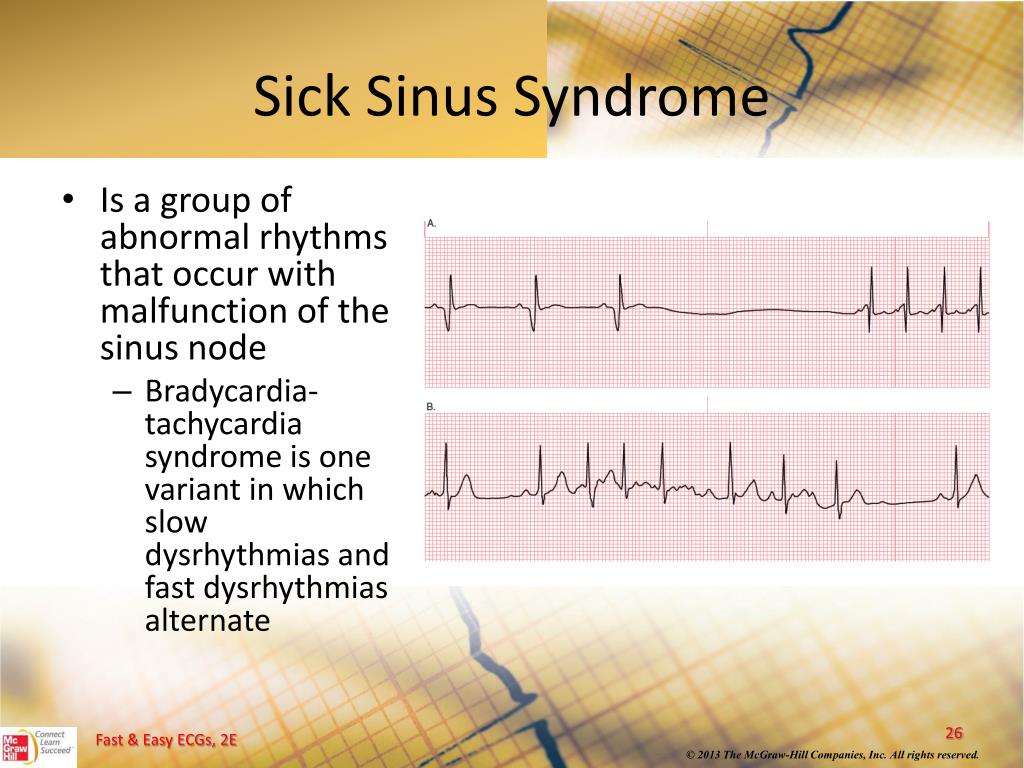
/548000499-56a471363df78cf772826afc.jpg)
Nomenclature for cardiac pacemaker mode selection is also referenced throughout this document. UKPACE – United Kingdom Pacing and Cardiovascular Events PASE – Pacemaker Selection in the Elderly NASPE – North American Society of Pacing and Electrophysiology (now known as the Heart Rhythm Society) LVFS – left ventricular fractional shortening HAS – Haute Autorité de Santé (French: High Authority for Health)
#Sick sinus syndrome treatment guidelines full#
Please find below a list of these acronyms and corresponding full terminology.ĪCCF – American College of Cardiology FoundationīPEG – British Pacing and Electrophysiology GroupĬTOPP – Canadian Trial of Physiologic Pacing Throughout this document we use numerous acronyms, some of which are not defined as they are presented in direct quotations. Medicare Administrative Contractors will determine coverage under section 1862(a)(1)(A) of the Social Security Act for any other indications for the implantation and use of single chamber or dual chamber cardiac pacemakers that are not specifically addressed in this national coverage determination. Symptoms of bradycardia are symptoms that can be directly attributable to a heart rate less than 60 beats per minute (for example: syncope, seizures, congestive heart failure, dizziness, or confusion). The Centers for Medicare & Medicaid Services (CMS) has determined that the evidence is sufficient to conclude that implanted permanent cardiac pacemakers, single chamber or dual chamber, are reasonable and necessary for the treatment of non-reversible symptomatic bradycardia due to sinus node dysfunction and second and/or third degree atrioventricular block. Single Chamber and Dual Chamber Permanent Cardiac Pacemakers. Subject:ĝecision Memorandum for Reconsideration of Coverage of Cardiac Pacemakers: Medicare Administrative Contractors will determine coverage under section 1862(a)(1)(A) of the Social Security Act for any other indications for the implantation and use of single chamber or dual chamber cardiac pacemakers that are not specifically addressed in this national coverage determination.ĭeputy Director, Coverage and Analysis Groupĭirector, Division of Medical and Surgical Services A clinical condition in which pacing takes place only intermittently and briefly, and which is not associated with a reasonable likelihood that pacing needs will become prolonged.Frequent or persistent supraventricular tachycardias, except where the pacemaker is specifically for the control of the tachycardia.Asymptomatic bradycardia in post-myocardial infarction patients about to initiate long-term beta-blocker drug therapy.Right bundle branch block with left axis deviation (and other forms of fascicular or bundle branch block) without syncope or other symptoms of intermittent atrioventricular block.Asymptomatic second degree atrioventricular block of Mobitz Type I unless the QRS complexes are prolonged or electrophysiological studies have demonstrated that the block is at or beyond the level of the His Bundle (a component of the electrical conduction system of the heart).Ineffective atrial contractions (e.g., chronic atrial fibrillation or flutter, or giant left atrium) without symptomatic bradycardia.Asymptomatic sino-atrial block or asymptomatic sinus arrest.Asymptomatic first degree atrioventricular block.Reversible causes of bradycardia such as electrolyte abnormalities, medications or drugs, and hypothermia.The following indications are non-covered since there is insufficient evidence to conclude that implanted permanent cardiac pacemakers, single chamber or dual chamber, are reasonable and necessary: Documented non-reversible symptomatic bradycardia due to second degree and/or third degree atrioventricular block.Documented non-reversible symptomatic bradycardia due to sinus node dysfunction.Therefore, the following indications are covered for implanted permanent single chamber or dual chamber cardiac pacemakers: Than 60 beats per minute (for example: syncope, seizures, congestive heart failure, dizziness, or confusion). Symptoms of bradycardia are symptoms that can be directly attributable to a heart rate less



 0 kommentar(er)
0 kommentar(er)
